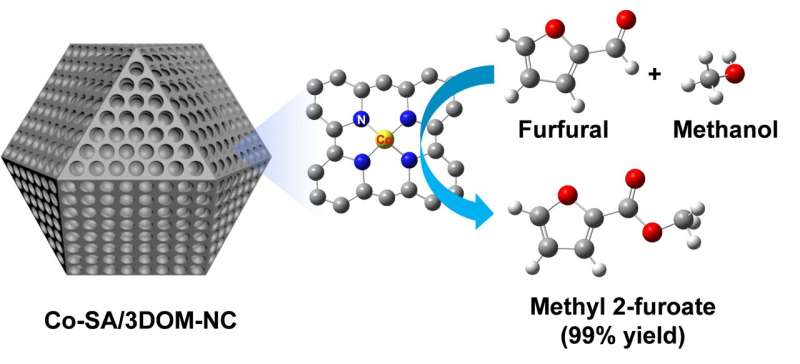This article has been reviewed according to Science X's editorial process and policies. Editors have highlighted the following attributes while ensuring the content's credibility:
fact-checked
trusted source
proofread
Researchers construct macroporous structure for single-atom catalysts

Single-atom catalysts are prized because of the way they maximize the use of active sites and because they have easy tunability. However, in most conventional single-atom catalysts, the active sites are buried in the thick microporous supports, resulting in low accessibility of the active sites, leading to low catalytic activity. A team of scientists has constructed a macroporous structure that provides enhanced accessibility of the active site in single-atom catalysts. Their work was published in the journal Industrial Chemistry & Materials on December 2022.
"We aim to build a highway in the support for the enhanced accessibility of the active site in single-atom catalysts," explains Yingwei Li, a professor at the South China University of Technology. Three-dimensional ordered macroporous support can serve as a highway for the single-atom sites, allowing the high mass transfer of reactants to reach the active sites.
The research team has developed three-dimensional-ordered macroporous carbon-anchored cobalt single-atom catalysts. Their catalysts show high activity in the oxidative esterification of furfural, representing the first example of macro-microporous metal-organic framework-derived single-atom catalysts used for biomass upgrading.
Renewable biomass resources, such as corn stover, wheat straw, oat straw or barley straw, are promising alternatives for the supply of chemical intermediates and liquid fuels. Furfural is one of the key platform chemicals derived from lignocellulosic biomass. This lignocellulosic biomass is plant or plant-based materials, mostly agricultural residues, that are not used for food or feed.
Lignocellulosic biomass has the potential to be a very economical and highly renewable energy resource. Furfural, which has an annual production volume of more than 200,000 tons, can be used as the starting material to synthesize a variety of valuable chemicals.
In particular, a process called oxidative esterification can be used on furfural to produce alkyl furoates, which are widely used as flavor and fragrance components in the chemical industry. Precious metal-based catalysts show high activity for the oxidative esterification of furfural, but the scarcity of precious metals makes it unfavorable for use in industrial applications. Therefore, the development of efficient noble metal-free catalysts is highly desired for use with furfural.
Transition-metal single-atom catalysts with their maximum atomic utilization have been widely used in the fields of catalysis and energy. Metal-organic frameworks with porous structures can serve as platforms for the synthesis of single-atom catalysts. Especially, nitrogen-rich zeolitic imidazolate frameworks, called ZIFs, have been used as ideal precursors for the fabrication of single-atom catalysts. However, because most of the ZIFs are microporous in nature, the derived single-atom catalysts tend to have low porosity, which greatly hinders the mass transfer of reactants and the accessibility of active sites.
The research team was able to successfully fabricate a composite of cobalt single atoms anchored on nitrogen-doped carbon with a three-dimensional ordered macroporous structure, and they used it for the oxidative esterification of furfural. They used pyrolysis of ordered macro/microporous zinc cobalt ZIF in creating the composite. Pyrolysis is a process where decomposition is brought about by very high temperatures.
With this composite, the team achieved high activity in the oxidative esterification of furfural, achieving a 99% yield of methyl 2-furoate under mild reaction conditions. This is significantly superior to the yield achieved with the microporous and cobalt nanoparticle counterparts. In addition, the composite exhibits high stability, without apparent decrease of activity even after six runs.
Looking ahead, the research team hopes that their work might provide insights into the development of hierarchically porous support-anchored single-atom catalysts for various catalytic applications.
"We next plan to scale up the production of the composite to achieve the ultimate goal of industrial application. Our developed catalyst may be potentially applied in various bulky molecule-involved catalytic applications, such as biomass valorization and pharmaceutical manufacturing," said Li.
More information: Wen Yao et al, Hierarchically ordered porous carbon with atomically dispersed cobalt for oxidative esterification of furfural, Industrial Chemistry & Materials (2022). DOI: 10.1039/D2IM00045H
Provided by Chinese Academy of Sciences



















